The Communicative Engineer: How to Ask, Listen, Write, Speak, and Use Visuals, Wiley, 2024.
Practicing engineers spend about half their time communicating ideas, facts, and feelings but invest only a small part of their formal education learning how to communicate. The Communicative Engineer closes that gap. When used as a textbook for students or a resource for practitioners, this book shows engineers in all disciplines how to use five communication modes—asking, listening, writing, speaking, and visuals—to participate in or lead successful engineering projects and achieve personal success and significance.
For the benefit of society, more of today’s and tomorrow’s engineers should complement their technical competency with communication competency in order to function and sometimes lead in an increasingly complex socio-economic-political environment. That is the motivation for writing this book.
|
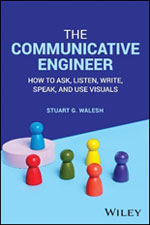
|
Book’s Three-part Purpose:
1. Demonstrate how effective communication results in successful engineering projects and other engineering endeavors. Engineering students and practitioners should understand the critical role of communication in project success. Miscommunication frequently produces failures resulting in fatalities, injuries, and property and environmental destruction.
2. Describe effective communication as drawing on six communication modes—asking, listening, writing, speaking, visuals, and mathematics—to convey ideas, information, and feelings.
3. Show how to apply the first five modes, using hypothetical and actual engineering situations. The intended result: communicative engineers; a safer society; and better-served clients, customers, and stakeholders.
The Communicative Engineer’s premise is that most engineering students and young engineer practitioners are poised to become effective communicators. Why? Because of their intelligence and persistence. Furthermore, they have access to and can learn from exemplary engineer communicators, many of whom are featured in this book.
Table of Contents:
- Preface
- Chapter 1. Introduction
- Chapter 2. Asking and Listening
- Chapter 3. Writing
- Chapter 4. Speaking
- Chapter 5. Using Visuals
Each chapter includes cited sources and a set of exercises.
The book concludes with seven appendices and an index. Some appendix titles: Examples of Communicative Engineers, Examples of Questions and What Can Be Learned from Them, and Punctuation Guidelines.
A thorough index and detailed table of contents help you find topics of interest.
Click here for excerpts from The Communicative Engineer.
Testimonials: Since publication, varied individuals have shared comments about the book. See examples of their views.
Click here to learn about and consider purchasing The Communicative Engineer.
If you have questions or suggestions about The Communicative Engineer, please contact author Stu Walesh at stu-walesh@comcast.net or 219-242-1704. He welcomes opportunities to speak, write, teach, or collaborate about topics related to his book.
Engineering’s Public-Protection Predicament: Reform Education and Licensure for a Safer Society, Hannah Publishing, 2021.
Book’s Three-part Purpose:
- Celebrate American engineering’s excellent achievements as well as the lives of engineer exemplars. Show how engineering enhances the nation’s quality of life.
- Advocate for the elimination, or reduction of the adverse effects, of U.S. laws that exempt industries, manufacturers, utilities, government entities, and other organizations from engineering licensure—and suggest ways to do it. These laws escalate public risk.
- Urge the broadening and deepening of engineering education and experience required for U.S. licensure as a professional engineer (PE) to be consistent with twenty-first century scientific, technological, social, political, economic, and environmental conditions—and suggest ways to do it. Stop using an inadequate nine-decade old licensure model.
The book’s premise is that American engineering’s ideology should be meeting society’s physical needs while protecting the public, as illustrated here: |
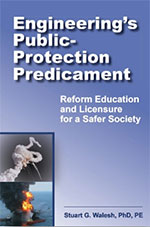
|
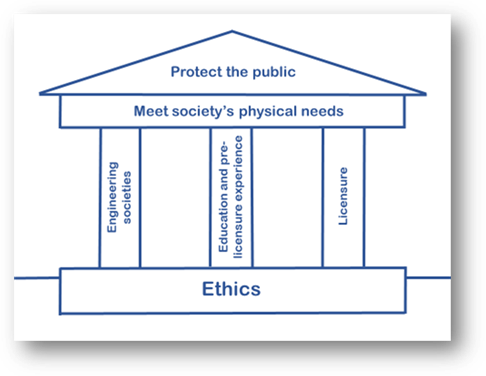
In a nutshell, this book seeks to celebrate engineering and its leaders; replace or diminish licensure exemptions, which handcuff engineers and put the public at unnecessary risk; and broaden and deepen the basic preparation of PEs - who serve as engineers in responsible charge - so they can be even more effective in technical and nontechnical ways.
Table of Contents:
- Preface
- Chapter 1. Ten Questions About Engineering in America
- Chapter 2. Engineering Excellence and Engineer Exemplars
- Chapter 3. Disaster: Were Some Caused by Licensure-Exemption Cultures?
- Chapter 4. Evolution of Engineering’s Institutional Framework: Part 1 – Ethics and Engineering Societies
- Chapter 5. Evolution of Engineering’s Institutional Framework: Part 2 – Education and Licensure
- Chapter 6. What is a Profession, and Is Engineering One?
- Chapter 7. Reforming U.S. Engineering: Suggestions for Organizations and Individuals
The book concludes with nine appendices, cited sources list, and an index. Appendix topics include the engineering body of knowledge (EBOK), discipline-specific licensure, control of ABET by licensure-exemption supporters, example of a state’s inconsistent licensure laws, and a potential stronger role of federal agencies in reducing risks in engineering projects.
Learn More and/or Purchase: Click here to learn more about and to consider purchasing the e-book version.
Testimonials: Several months before publication of Engineering’s Public-Protection Predicament, varied individuals agreed to review an advanced reader copy (ARC). Their comments appear here.
Example Text: For a further introduction to the book, click here to read excerpts from various chapters.
Predicament? Why use the word predicament in the title? Click here for the answer.
Boeing’s Culture: Exemptions to engineering licensure laws tend to create bottom-line-first cultures (not public-protection-first cultures). Boeing provides an example.
Suggested Solutions: U.S. engineering faces many challenges. In the spirit of moving forward, the last chapter of Engineering’s Public-Protection Predicament offers numerous suggested remedial actions for consideration by organizations and individuals within and outside of engineering.
- The book presents suggestions for consideration by the following organizations: ABET, ACEC, ASCE, NAE, NCEES, NSPE, discipline-based engineering societies, state and territory licensing boards, representative federal agencies, and government watchdog groups.
- Individuals addressed include potential engineering students and their parents and counselors, engineering students, engineering deans and faculty members, PEs, and graduate engineers employed by licensure-exempt organizations.
Author’s Statement: I present, in this book, my findings and remedial suggestions with love for engineering, the potentially greatest profession because of its impact on society. Even with its faults, I respect what American engineering has accomplished, yearn for how much more it could be, and appreciate the opportunities and resulting life engineering has given to me.
If you have questions or suggestions about the book, please contact author Stu Walesh at stu-walesh@comcast.net or 219-242-1704.
Introduction to Creativity and Innovation for Engineers, Pearson Education, 2017.
This book provides engineering students and practitioners with neuroscience-based knowledge and methods that enable them to be much more creative and innovative as individuals and team members. Readers will strengthen their organizations, provide more effective products and services, advance their careers, and experience the thrill of doing what has never been done.
Unique Brain-Based Foundation
This book is special in the world of engineering texts in that it alone explicitly builds on brain basics most of which have been discovered or advanced in the past few decades. The premise is that the brain is an instrument and “playing” it effectively demands an understanding of how it works. This is “Neuroscience 101” – not brain surgery knowledge – and it is practical and immediately applicable by students and practitioners |
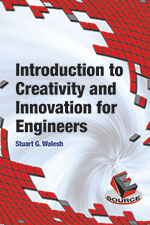 |
A 20-Method Toolbox
After constructing a brain basics foundation, the text is organized so that the readers learn about 20 stimulating and collaborative methods to help them and their teams work smarter – more effective, efficient, creative, and innovative. Each item in this cognitive toolkit is described, with examples, followed by discussion of the method’s neuroscience basis and its positive and negative features. Readers are shown how to mix and match these tools just as they would with software tools at their desk or hand tools in a workshop. The book also identifies the innate, often under-utilized characteristics of creative-innovative individuals.
Many and Varied Examples from Within and Outside of Engineering
The text presents 90 highly varied examples of creative-innovative results from within and outside of engineering. They include systems, facilities, structures, products, and processes along with their benefits. The descriptions suggest the broad application of a creative-innovative mindset and the resulting benefits in both the technical (e.g., research, analysis, planning, design, manufacturing, construction, operations) and non-technical (e.g., finance, marketing, human resources, management, leadership) aspects of engineering. Studying these examples, which appear throughout the book, stimulates the reader because they show the value of personal characteristics such as empathy, studiousness, experimentation, and persistence. The examples also illustrate ways to overcome the resistance to change typically encountered when bold new ideas are offered and demonstrate the potential positive impacts of the creative-innovative process.
Introduction to Creativity and Innovation for Engineers should be read by most engineering students and young practitioners because it opens a window to topics not usually included in their formal education.
Practical “Stuff”
The author realizes that some practitioners will view this book as being academic, theoretical, ivory tower, touchy-feely, and philosophical. He has received such reactions. The book is 180 degrees from that. This is practical “stuff” that capitalizes on the combination of what we have learned in recent years about that three-pound marvel between our ears and the typical superior intelligence of engineers and similar scientific-technical professionals.
Table of Contents:
- Preface
- Chapter 1. Why Should You Learn More About Creativity and Innovation?
- Chapter 2. The Brain: A Primer
- Chapter 3. Prelude to Whole-Brain Methods
- Chapter 4. Basic Whole-Brain Methods
- Chapter 5. Overcoming Obstacles to Creativity and Innovation
- Chapter 6. Characteristics of Creative and Innovative Individuals
- Chapter 7. Advanced Whole-Brain Methods
- Chapter 8. Creativity and Innovation Examples from Various Engineering Disciplines
- Chapter 9. Moving On: The Next Move is Yours
- Appendix A. Abbreviations
- Appendix B. Glossary
- Index
Faculty and students, click here for more information about the book and to order it in soft cover, as an e-Book, or in the form of one or more chapters.
Workshop Based on Book
Might you and your organization (business, government, academic, volunteer, etc.) be interested in a half-day or longer “working smarter” workshop that would draw on the book and address some of your issues, problems, and opportunities? If so, refer to a suggested workshop outline available here. I would work with you to tailor the workshop to your needs. If a workshop interests you, please contact me at 219-242-1704 or stu-walesh@comcast.net.
Comments about the Book:
The writing is clear with many references to the related legacy work. The first several chapters are great resources for supporting “thinking about thinking” and the idea that metacognition is indeed a key to changing a mindset. I really like the table of contents, it’s better than most, and I appreciate the exercises. Your book is a …valuable text for instilling an entrepreneurial mindset in undergraduate engineering students.
-- Douglas E. Melton, Ph.D., Program Director for the Entrepreneurial Engineering Program and the Kern Entrepreneurial Engineering Network (KEEN), The Kern Family Foundation, Wisconsin, USA.
Walesh lays out logical paths for taking a “whole-brain” approach. Flipping randomly to any page, the impression is not your typical how-to-engineering boilerplate. Some pages have a da Vinci-esque vibe going on. It’s a refreshing way to tackle the subjects.
-- Lindsay Brooke, Editor-in-Chief, Automotive Engineering, Society of Automotive Engineers (SAE) International reviewing the book in an editorial in Automotive Engineering titled “Stoking the Creative, Innovative Engineer.”
Stuart Walesh has done something I've thought about doing for a long time - create an innovation "textbook" that is a holistic look at what innovation is, its place in business, and how to do innovation effectively. Mr. Walesh has produced an excellent textbook with a focus on innovation specifically for engineers and technologists. Walesh clearly hopes that schools and universities will adopt the book and "teach" innovation to engineers. I think this is an excellent idea, but many academic programs may not understand the value of teaching innovation methods alongside more "rigorous" engineering disciplines. That's a mistake. We need to teach young engineers calculus and thermodynamics, but we also need to teach them how to solve really interesting, difficult problems with creativity and new ways of thinking.
-- Jeffrey Phillips, Vice-President Marketing, OVO Innovation, Raleigh, NC and NetCentrics, Herndon, VA.
My students and I enjoyed the book immensely. Several student groups conducted presentations based on the book. We need to teach our younger students the value of being creative and innovative. I enjoy the practical applications in the text as well as the case studies. I am planning to work some of the concepts you introduce into some leadership seminars/mini-lectures because both the appreciation and application of creativity and innovation is what will separate great leaders from average ones.
-- Decker B. Hains, Ph.D., P.E., PMP, Master Specialist, Civil and Construction Engineering, Western Michigan University, Kalamazoo, MI.
Walesh dives into teaching creativity from a number of angles geared to young engineers. His treatment covers why creativity is important and includes a primer on the brain. Readers learn about “whole- brain” methods of thinking, strategies for overcoming obstacles to creativity, and much more. The text is admirably designed to equip students with the tools they need to succeed.
-- Ray Bert, Contributing Editor, ASCE, reviewed in Civil Engineering, April 2016.
Dr. Stuart Walesh, an accomplished practitioner and educator, envisions an age of conception—one where the ability to generate feasible, surprising, and patentable concepts is a key competitive advantage. His latest book is a source of inspiration for established professionals, a textbook for aspiring engineers, and a roadmap to the future of our profession … leaders in the field should intentionally model creative behavior. With Dr. Walesh’s book in hand, that will be easier than you think.
-- Jeffrey S. Russell, Ph.D., P.E., Vice Provost for Lifelong Learning, Dean of Continuing Studies, and Professor of Civil and Environmental Engineering, University of Wisconsin – Madison.
This is really excellent – the first comprehensive overview of the creativity/innovation subject matter that I have read that is geared toward the engineer. The creativity/innovation topic is unfortunately overlooked at the university -- this would make an excellent textbook. The exercises at the end of the chapters are great!
-- Steven D. Sanders, Ph.D., P.E., Vice-President, Burgess & Niple, Dallas, TX.
This book is a celebration of engineering accomplishments and the human brain’s capacity to conceive and build them…The underlying theme permeating the book is the idea that creative thought need not be an unpredictable bolt of inspiration; it is a learnable skill that must be cultivated deliberately by engineers to successfully tackle grand challenges now and in the future.
-- Ranjit S. Sahai, P.E., President, RAM Corporation, Dulles, VA.
This book in not just a labor of love, and it’s not just a book of information…it’s a book that contains gold nuggets of effect, context, and consequences. It is a gift to our industry.
-- Dan Kelleher, P.G., President, Midwest GeoSciences Group, Carmel, IN.
Engineering Your Future: The Professional Practice of Engineering - Third Edition, John Wiley and Sons and ASCE Press, 2012.
Technical competency, the "hard side" of engineering and other technical professions, is necessary but not sufficient for success in business. Young engineers must also develop nontechnical or "soft-side" competencies like communication, marketing, ethics, business accounting, and law and management in order to fully realize their potential in the workplace.
This updated edition of Engineering Your Future is the go-to resource on the nontechnical aspects of professional practice for engineering students and young technical professionals alike. The content is explicitly linked to current efforts in the reform of engineering education, including ABET's Engineering Criteria 2000 and ASCE's Body of Knowledge. The book treats essential nontechnical topics you'll encounter in your career, like self-management, interpersonal relationships, teamwork, project and total quality management, design, construction, manufacturing, engineering economics, organizational structures, business accounting, and much more. |
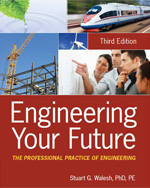 |
Features new to this revised edition include: a stronger emphasis on management and leadership; a focus on personal growth and developing relationships; expanded treatment of project management; coverage of how to develop a quality culture and ways to encourage creative and innovative thinking; a discussion of how the results of design, the root of engineering, come to fruition in constructing and manufacturing, the fruit of engineering; new information on accounting principles that can be used in your career-long financial planning; and an in-depth treatment of how engineering students and young practitioners can and should anticipate, participate in, and ultimately effect change.
Engineering Your Future is essential reading for students or young practitioners at the beginning of their engineering careers because it presents topics often not included in formal education.
Table of Contents:
- Preface to the Third Edition.
- List of Abbreviations.
- Chapter 1. Introduction: Engineering and the Engineer.
- Chapter 2. Leading and Managing: Getting Your Personal House in Order.
- Chapter 3. Communicating to Make Things Happen.
- Chapter 4. Developing Relationships.
- Chapter 5. Project Management: Planning, Executing, and Closing.
- Chapter 6. Project Management: Critical Path Method and Scope Creep.
- Chapter 7. Quality: What is It and How Do We Achieve It?
- Chapter 8. Design: To Engineer is to Create.
- Chapter 9. Building: Constructing and Manufacturing.
- Chapter 10. Basic Accounting: Tracking the Past and Planning the Future.
- Chapter 11. Legal Framework.
- Chapter 12. Ethics: Dealing with Dilemmas.
- Chapter 13. Role and Selection of Consultants.
- Chapter 14. Marketing: A Mutually-Beneficial Process.
- Chapter 15. The Future and You.
- Appendix A: Engineering Your Future Supports ABET Basic Level Criterion 3.
- Appendix B: Engineering Your Future Supports ABET Program Criteria for Civil and Similarly-Named Engineering Programs.
- Appendix C: Engineering Your Future Supports the Civil Engineering Body of Knowledge
To learn more and/or to order, click here.
Click here for a description of the book; its table of contents; and ordering as a soft cover, an e-Book, or one or more chapters.
Comments about the Third Edition:
I reference this book so often as an engineer and project manager - Stu has provided the key formulas we need for convincing clients the long term implications of "management by failure" vs. investment in "doing it right" the first time... You can find these formulas on the internet - but I bet you can't find them all in one place like this, not to mention they are the ones specifically for our trade. Lots of other great references and real world experience shared also.
-- Comments on Amazon by reviewer Sam Civil
Argues that technical competency -- the "hard side" of engineering and other technical professions -- is necessary, but not enough. Rather, new generations must also develop "soft-side" competencies in communication, project management, accounting, marketing, ethics, law, and leadership to fulfill their potential.
-- Comments in On Wisconsin Magazine - University of Wisconsin, Winter 2012.
Engineering Your Future is an essential guide for students and young practitioners on the nontechnical aspects that can advance or derail an engineering career...While part of the book's strength is much of the advice and wisdom that applies to any vocation, its conception and execution as a work tailored to the needs of engineers make it far more valuable than most of the titles populating the "getting ahead" shelves at the bookstore.
- Reviewed in Civil Engineering - ASCE, April 2012.
The book is compelling and comprehensive. Professors who choose to implement your book are wise and their students more fortunate than they will initially realize...Your personal reflections were lessons in themselves to young practitioners.
- Robert Boller, former high school principal.
Comments about the Second Edition:
As an engineer in today’s consulting world, you are expected not only to be a technical expert but also possess business savvy…This is where Engineering Your Future will help you. It fills in the blanks from your engineering classes…For the young engineer, nothing can replace actual work experience, but why not be prepared? Give yourself a head start. Read Engineering Your Future. When your boss starts talking about a 3.0 multiplier, you will be glad you did.
-
Reviewed in Leadership and Management in Engineering – ASCE, June 2001.
A must read for all students currently majoring in civil engineering as well as young technical professionals…[with] so many helpful tips and practical nuggets, even the experienced practitioner will benefit from reading this book.
- Dr. Jeffrey S. Russell, P.E., Chair, Department of Civil and Environmental Engineering, University of Wisconsin, Madison, WI commenting on Engineering Your Future.
Walesh covers all of the pertinent career-planning topics including self-management, communications, relationships with others, ethics, and leadership.
- Ed Bergeron, P.E., President of H. E. Bergeron Engineers and author of A Pocket Guide to Business for Engineers and Surveyors.
Managing and Leading: 52 Lessons Learned for Engineers, ASCE Press, Reston, VA 2004
This “handbook” style book offers useful ideas on ways in which engineers and other technical professionals can more effectively approach the non-technical or “soft-side” aspects of working with colleagues, clients, customers, the public, and other stakeholders. Presented are 52 essays, each offering an idea or principle for professionals to improve their managing and leading knowledge and skills. Each essay is followed by pragmatic suggestions for ways to immediately apply and test the ideas and principles. Examples of managing and leading topics treated in this book are distinctions between managing and leading, goal setting and achieving, courage, asking and listening, speaking fear, presenting papers, kinesthetic learners, coaching, power of the subconscious mind, delegation, mentoring and coaching, team essentials, project planning and management, a marketing model, style, and effecting change. |
 |
This book might be a catalyst for releasing the leader within you. More specifically, the categories of lessons in this book are:
Personal Roles, Goals, and Development
Communication
Learning and Teaching
Improving Personal and Organizational Productivity
Meetings
Marketing
Building Mutually-Beneficial Employee-Employer Partnerships
The Broad View
All consultants to management—especially those just starting their careers—can nonetheless benefit from it. Given its title and publisher, the book appears to be directed at engineers, but everyone directly involved in business or consulting who is striving to advance within an organization will find that 90% of the lessons apply to them…the great majority [of lessons] reflect Walesh’s solid experience as a solo consultant, scholar, and academic.
-
Reviewed in Consulting to Management, December, 2004.
If one of your New Year’s resolutions is to make yourself a more effective leader, both personally and professionally, here is a tool for you. Managing and Leading: 52 Lessons Learned for Engineers is a fun and easy-to-read compilation of vignettes, each illustrating a specific point or goal and followed by practical steps for applying the ideas presented…the book is written to engineers, yet applicable to anyone.
-
May, 2004 review by AIArchitect, American Institute of Architects.
It offers the engineer a book with a wide range of ideas, insights, and suggestions on furthering his/her career—and increasing management and leadership skills. Any engineer who is advancing in management, or who wants to improve their chances of being a leader, would be a market for this book.
- Comments by Richard Weingardt, P.E. Hon.M.ASCE, CEO and Chairman, Richard Weingardt Consultants, Inc.
To learn more and to purchase, click here!
Managing and Leading: 44 Lessons Learned for Pharmacists, American Society of Health-System Pharmacists, Bethesda, MD, 2008 authored by Paul W. Bush and Stuart G. Walesh
This book supports my contention that basic managing and leading principles apply to various professions. That is, principles articulated for and tested by engineering students and practitioners as published in Managing and Leading: 52 Lessons Learned for Engineers were readily adapted to pharmacy students and practitioners.
This book offers useful ideas and tools for pharmacists, residents, and students to improve their managing and leading skills, and more effectively approach the non-technical or “soft-side” aspects of working with colleagues, administrators, vendors, clients, patients, and other stakeholders. Each of the 44 lessons in this book contains an essay that offers at least one idea or principle for honing management and leadership effectiveness. |
 |
Each essay is followed by practical suggestions for ways to apply the ideas using application tools and techniques such as action items, guidelines, do’s and don’ts, checklists, forms, and resource materials such as articles, books, e-newsletters, and websites.
Lessons are focused in the following categories: personal roles, goals and development; communication; learning and teaching; improving personal and organizational productivity; meetings and agendas; marketing models; building mutually-beneficial employee-employer partnerships; and a process for effecting change. A sampling of specific topics: goal setting, job security versus career security, effectiveness and efficiency, team essentials, project planning, meeting planning, a marketing model, behavioral interviewing, the visual learner, speaking fear, and the power of the subconscious mind. The categories of lessons in this book are:
Personal Roles, Goals, and Development
Communication
Learning and Teaching
Improving Personal and Organizational Productivity
Meetings
Marketing
The Broad View
…One of the book’s strong points is that the lessons are succinct and applicable to real-life situations and are tied in with other lessons…This book is extremely user-friendly and can be utilized in a wide variety of settings…interesting quotes throughout the text…This book is unique among other managerial references in that its focus is for professional pharmacists…This book stands out from other reference books because the focus is on effective pharmacy leadership, not on being a leader based on business experience, athletic prowess, or political affiliations…I would recommend it for individuals’ self-development collection, drug information libraries, and all practitioners searching for management insights.
-
Review by Dr. Joseph E. Mazur, Medical University of South Carolina, Charleston, SC in The Annals of Pharmacotherapy, October 2008.
To learn more and purchase, click here!
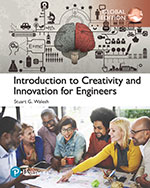
Introduction to Creativity and Innovation for Engineers –
Global Edition, Pearson Education, 2017
Pearson, the publisher, selected this book for inclusion in its Global Edition program. This special effort aims to provide education resources to learners worldwide and does so with modest changes in content and with attractive pricing. It is available outside of North America with the highest sales in the United Kingdom, across Asia, and Australia. For a description of the book’s essential features, refer to the third book described on this page.
Click here for more information about the global edition book.
Flying Solo: How to Start an Individual Practitioner Consulting Business, Hannah Publishing, Valparaiso, IN 2000
Are you an engineer or other technical professional who is “on the fence” regarding going out on your own? Flying Solo will help you make a “go” or “no go” decision. If it’s a “go,” this book will explain, in a pragmatic comprehensive manner, how to get started. This book is also relevant to the entrepreneur who has recently gone into a sole proprietor consulting business in that the book’s practical ideas and information will help save or accelerate the business. Flying Solo will help you, as an independent consultant, enjoy your work, increase autonomy and income, and prepare for comfortable “on your terms” retirement. Examples of topics discussed in this book are the demise of job security, qualifications-based selection, a marketing model, project planning and management, billable time, and errors and omissions. The chapters in this book are: |
 |
- Introduction
- Telltale Signs: Some Reasons to Consider “Going Out On Your Own”
- Roles and Selection of Consultants
- Success Factors
- Assessing Your Assets
- Logistics of Getting Started
- Marketing: Sleazy Activity or Mutually-Beneficial Process?
- Tips on Being Successful With a New Client
- Project Management
- Business and Personal Accounting: Keeping Financial Score
- Liability and How to Minimize It
- What if You Fail?
…this is a useful introduction for technologists who think they may want to be independent consults.
-
Reviewed in Consulting to Management, June, 2001.
This book is out of print but may be in libraries or available used.
Learn More About Stu Walesh | Clients Served | Testimonials & Reviews
Managing and Leading Books | Tailored Education & Training
Home | Legal Notice | Privacy Statement | Site Map
Copyright © Stuart G. Walesh Ph.D. P.E. Dist.M.ASCE
Web Site Design, Hosting & Maintenance By Catalyst Marketing / Worryfree Websites |

